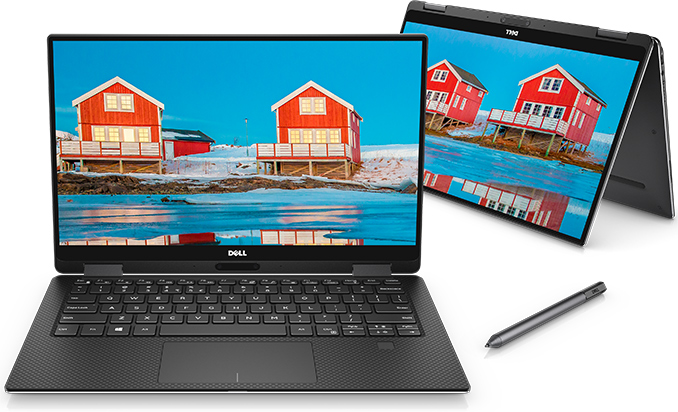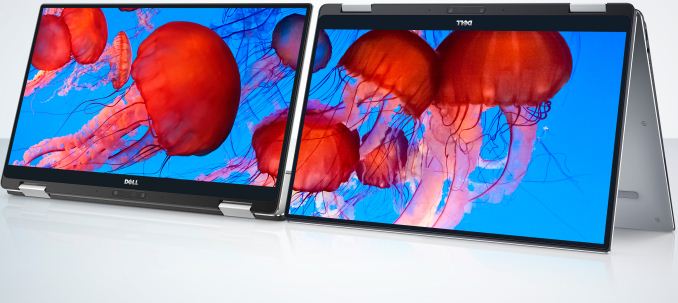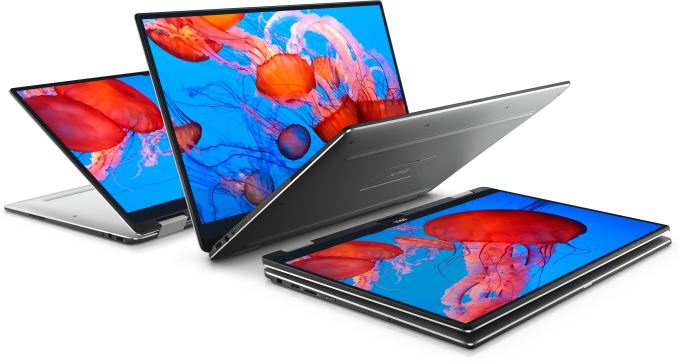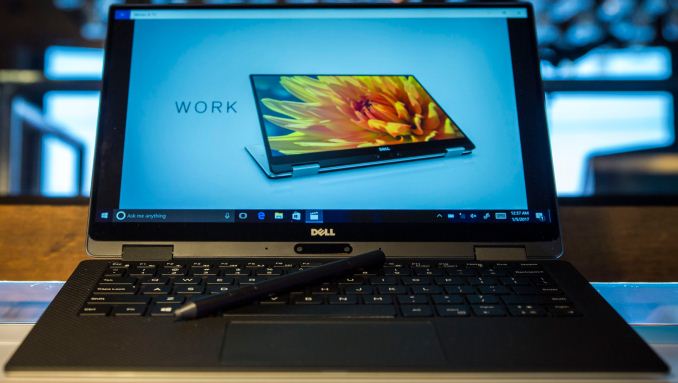Dell Refreshes XPS 13 2-in-1: Amber Lake 5W CPUs with Thunderbolt 3
by Anton Shilov on August 29, 2018 1:30 AM EST- Posted in
- Laptops
- Dell
- XPS
- Trade Shows
- Notebooks
- XPS 13
- Thunderbolt 3
- Amber Lake
- IFA 2018

Dell on Wednesday upgraded its XPS 13 2-in-1 convertible laptops with Intel’s latest 8th Gen Core (codenamed Amber Lake-Y) processors. The new systems have retained the chassis and displays used on the previous-generation XPS 13 2-in-1, but because of the new CPUs they now can offer higher performance. Also, the new XPS 13 2-in-1 offer more DRAM and a higher-capacity SSDs.
The 2018 Dell XPS 13 2-in-1 (9365) systems share their CNC-machined aluminum enclosure and display options with the previous-gen convertibles carrying the same brand. Dell will offer the new mobile PCs with 13.3-inch InfinityEdge multitouch displays featuring a 1920×1080 or a 3200×1800 resolution along with a 400-nits brightness, a 1000:1 contrast ratio, and 170°/170° viewing angles. The screens are covered with Corning’s Gorilla Glass 4 for protection. Ultrathin bezels of InfinityEdge displays come at a price: the XPS 13 2-in-1 hybrid laptops have their webcam installed beneath the display, which many users find odd. Speaking of webcam, it is Windows Hello compliant, has a 720p resolution and is accompanied by stereo speakers and a microphone array.
When it comes to CPU options, then the new XPS 13 2-in-1 (9365) convertible systems may be equipped with Intel’s latest Core i7-8500Y or Core i5-8200Y, or the previous-gen Core i7-7Y75 or Core i5-7Y54. Given the compatibility with older CPUs, it looks like the new convertibles not only retained the chassis, but also design of the motherboard.
Just like in case of predecessors, base models of the new XPS 13 2-in-1 convertibles will come with 4 GB of LPDDR3-1866 memory as well as a 128 GB SATA SSD. Meanwhile, higher-performance options may be equipped with 8 or 16 GB of LPDDR3-1866 DRAM as well as a 256 GB, 512 GB, or a 1 TB PCIe SSD. Both 16 GB RAM and 1 TB SSD options are new to the 9365 model as they were not available previously.
Moving on to connectivity. Like before, the new XPS 13 2-in-1 hybrid notebooks feature a 802.11ac Wi-Fi + Bluetooth 4.2 controller on the wireless side of things as well as two USB 3.1 Type-C headers and a Thunderbolt 3 port for physical devices. In addition, Dell’s new convertible has a microSD card reader and a TRRS headset jack.
Since we are dealing with an upgraded, but not an all new machine, its physical characteristics have not changed from the early 2017 model. The system weighs 1.24 kg (2.7 lbs.) and is 8 – 13.7 mm thick (0.32 – 0.54 inches). Dell continues to use a 46 Wh battery for its 2018 XPS 13 2-in-1 and says it lasts up to 15 hours (based on data from MobileMark 2014).
Dell plans to begin selling its 2018 XPS 13 2-in-1 shortly, depending on the market. Pricing will start at $999.99 for a base model, whereas more advanced SKUs will cost more. Optional accessories include a Thunderbolt 3 dock, a stylus, and other necessary gadgets.
Related Reading:
- Dell Releases The XPS 13 2-in-1 Convertible Ultrabook: Infinity Utility
- Dell Launches AMD Ryzen-Based Inspiron 13 7000 2-in-1 Convertible, Starts at $700
- The Dell Latitude 13 7390 2-in-1 Review
- Dell at CES 2018: Updates XPS 15 2-in-1 - Intel Kaby Lake-G CPU with Radeon RX Vega M Graphics
- Dell at CES 2018: Latitude 5000 and 7000 Series 2-in-1's Receive 8th Gen Intel













11 Comments
View All Comments
milkod2001 - Wednesday, August 29, 2018 - link
I suspect very crappy performance from those rebranded Atoms now Pentiums or Amber Lake confuse customers even more CPUs. They are OK for cheappo tablets at $200 but when one pay $1000 for laptop one could expect a bit more.Ian Cutress - Wednesday, August 29, 2018 - link
These aren't Atoms. This is the full Core microarchitecture from the mainstream line, just binned down to 5W.milkod2001 - Wednesday, August 29, 2018 - link
At 5W they are rebranded Atoms with pathetic performance.Death666Angel - Wednesday, August 29, 2018 - link
No. Please educate yourself about Y series processors, they have been done for some generations now (Ivy Bridge had 7W CPUs).smilingcrow - Wednesday, August 29, 2018 - link
Wrong on all counts but don't expect amazing performance in a fanless 2-in-1 anyway.milkod2001 - Wednesday, August 29, 2018 - link
When we get to read reviews it will come to my words. For $1000 it must have amazing performance! Not special gaming /workstation laptop amazing performance but still amazing performance. With 5W chips not matter the name it will suck.Dug - Wednesday, August 29, 2018 - link
You tell em milkod2001! (Who hasn't even used the laptop yet, and knows nothing about cpu design)BTW, previous iterations of the laptop have done just fine for any laptop work with any application, or in your words, it sucked.
Hxx - Thursday, August 30, 2018 - link
they are geared towards mobility not so much performance . they will never have a mid range / high end performing chip because their main focus is balancing battery consumption. So you either dont know what u need or you are flat out looking at the wrong item for your use.Samus - Thursday, August 30, 2018 - link
Calling Core Y an Atom is a stretch.The slowest Core-Y ever produced, the m3-6Y30, outperforms the fastest "Atom" ever produced...the C2750, and completely crushes it in single threading (3 times faster) because of the Core microarchitecture roots.
If you are having trouble separating your Atom obsession from the Core-based Y parts, because they aren't "good" enough to call Core in your mind, then think of it as an in-between, not an Atom, not a Core (although it really is a Core, down to the chipset)
Danavl - Wednesday, August 29, 2018 - link
I have the i7-7Y75 from the earlier model XPS 13 2in1 and it's Amazing! Definitely not comparable to Atom or even the previously Core-M branded processors.I get a consistent 10+ hours battery life, work daily as a IT professional with 50+ chrome tabs open, Office, Adobe, the usual, and at home use it for Netflix and light gaming, Minecraft, etc. and performance is excellent.